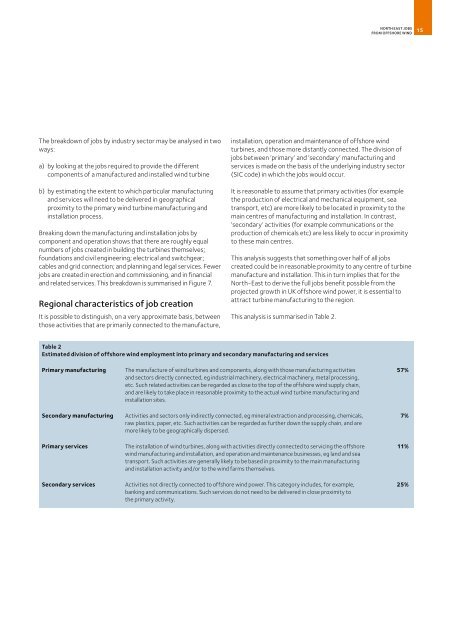offshore wind onshore jobs - a new industry for ... - Greenpeace UK
offshore wind onshore jobs - a new industry for ... - Greenpeace UK
offshore wind onshore jobs - a new industry for ... - Greenpeace UK
You also want an ePaper? Increase the reach of your titles
YUMPU automatically turns print PDFs into web optimized ePapers that Google loves.
NORTH EAST JOBS<br />
FROM OFFSHORE WIND<br />
15<br />
The breakdown of <strong>jobs</strong> by <strong>industry</strong> sector may be analysed in two<br />
ways:<br />
a) by looking at the <strong>jobs</strong> required to provide the different<br />
components of a manufactured and installed <strong>wind</strong> turbine<br />
b) by estimating the extent to which particular manufacturing<br />
and services will need to be delivered in geographical<br />
proximity to the primary <strong>wind</strong> turbine manufacturing and<br />
installation process.<br />
Breaking down the manufacturing and installation <strong>jobs</strong> by<br />
component and operation shows that there are roughly equal<br />
numbers of <strong>jobs</strong> created in building the turbines themselves;<br />
foundations and civil engineering; electrical and switchgear;<br />
cables and grid connection; and planning and legal services. Fewer<br />
<strong>jobs</strong> are created in erection and commissioning, and in financial<br />
and related services. This breakdown is summarised in Figure 7.<br />
Regional characteristics of job creation<br />
It is possible to distinguish, on a very approximate basis, between<br />
those activities that are primarily connected to the manufacture,<br />
installation, operation and maintenance of <strong>offshore</strong> <strong>wind</strong><br />
turbines, and those more distantly connected. The division of<br />
<strong>jobs</strong> between ‘primary’ and ‘secondary’ manufacturing and<br />
services is made on the basis of the underlying <strong>industry</strong> sector<br />
(SIC code) in which the <strong>jobs</strong> would occur.<br />
It is reasonable to assume that primary activities (<strong>for</strong> example<br />
the production of electrical and mechanical equipment, sea<br />
transport, etc) are more likely to be located in proximity to the<br />
main centres of manufacturing and installation. In contrast,<br />
‘secondary’ activities (<strong>for</strong> example communications or the<br />
production of chemicals etc) are less likely to occur in proximity<br />
to these main centres.<br />
This analysis suggests that something over half of all <strong>jobs</strong><br />
created could be in reasonable proximity to any centre of turbine<br />
manufacture and installation. This in turn implies that <strong>for</strong> the<br />
North-East to derive the full <strong>jobs</strong> benefit possible from the<br />
projected growth in <strong>UK</strong> <strong>offshore</strong> <strong>wind</strong> power, it is essential to<br />
attract turbine manufacturing to the region.<br />
This analysis is summarised in Table 2.<br />
Table 2<br />
Estimated division of <strong>offshore</strong> <strong>wind</strong> employment into primary and secondary manufacturing and services<br />
Primary manufacturing The manufacture of <strong>wind</strong> turbines and components, along with those manufacturing activities 57%<br />
and sectors directly connected, eg industrial machinery, electrical machinery, metal processing,<br />
etc. Such related activities can be regarded as close to the top of the <strong>offshore</strong> <strong>wind</strong> supply chain,<br />
and are likely to take place in reasonable proximity to the actual <strong>wind</strong> turbine manufacturing and<br />
installation sites.<br />
Secondary manufacturing Activities and sectors only indirectly connected, eg mineral extraction and processing, chemicals, 7%<br />
raw plastics, paper, etc. Such activities can be regarded as further down the supply chain, and are<br />
more likely to be geographically dispersed.<br />
Primary services The installation of <strong>wind</strong> turbines, along with activities directly connected to servicing the <strong>offshore</strong> 11%<br />
<strong>wind</strong> manufacturing and installation, and operation and maintenance businesses, eg land and sea<br />
transport. Such activities are generally likely to be based in proximity to the main manufacturing<br />
and installation activity and/or to the <strong>wind</strong> farms themselves.<br />
Secondary services Activities not directly connected to <strong>offshore</strong> <strong>wind</strong> power. This category includes, <strong>for</strong> example, 25%<br />
banking and communications. Such services do not need to be delivered in close proximity to<br />
the primary activity.




![[2007] EWHC 311 - Greenpeace UK](https://img.yumpu.com/22079793/1/184x260/2007-ewhc-311-greenpeace-uk.jpg?quality=85)











